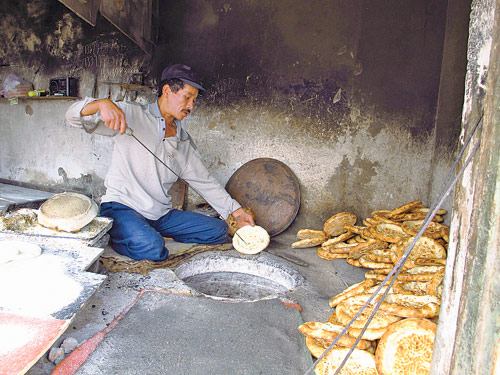
 |
|
The Tomb of Fragrant Imperial Concubine, built in the Qing Dynasty (1644-1911). |
 |
|
A baker makes the Uygur-style crusty nang. |
At a local family, we ran into preparations for a Uygur wedding. All shoes are left at the entrance in front of the house, which is fully covered by carpeting.
Children and female relatives are crammed into the house, helping with the preparation or just simply playing. Upstairs the bride lies down on the floor to make it easier for the makeup artist who deftly applies makeup to her face. In a few hours, the bridegroom will arrive and pick her up.
Outside, a five-member folk music group has already started performing. Uygur men can no longer sit tight - they get up to dance. Women inside the house are also attracted by the lively sounds and they come out to join the dancing.
They pose with arms and fling back their shoulders. They form a circle, dancing first in one direction and then the other. They also invite new arrivals to join in, turning the yard into a dance floor.
We bid farewell to the hospitable family when they were about to serve Xinjiang-style rice, made with a variety of grains and cooked with mutton, chicken or vegetable.
What lies ahead is the Karakul Lake, about 191 km from Kashgar city. Our car glided through the Gobi Desert, past snow-capped mountains. Small cottages that occasionally appear along the road are completely built from white stone.
Situated 3,600 meters above the sea level, the Karakul Lake is said to be the dressing mirror of the nearby mountains.
The gleaming snow and marshmallow clouds set off the extraordinary blue plateau lake, adding a mysterious and poetic element to the scene.
It only costs 20 yuan (about $3.25) to ride a horse or a camel. The herders guide the animals to the most beautiful spots at the lakeside, giving their customers great photo opportunities in the natural wonderland.